Broadway Row: 744-748 Broadway
Introduction
Author-Uploaded Audio
Listen to a narration of this entry's description by Kim Parker .
Text-to-speech Audio
The rowhouses located at the corner of Wilson Street and Broadway, sometimes referred to as Broadway Row, have a very rich history. This includes connections to some of Albany’s oldest families: the Van Schaicks and the Ten Broecks. Although the exact date of their construction is unknown, it is believed that they were built pre 1846, and possibly as early as 1831. In the past Broadway was lined with rowhouses, but due to years of demolition, these four beautiful Greek Revival buildings are the only ones that remain.
These rowhouses demonstrate various characteristics typical of Greek Revival architecture, specifically the presence of a cornice, a wide frieze band, simple moulded lintels and sills, and a recessed entrance with Doric pilasters or columns. While not included in either the Clinton Avenue Historic District or the Broadway-Livingston Historic District, which are each just a block away, these homes were officially listed on both the State and National Register of Historic Places in 1987.
Images
Broadway Row, Present Day
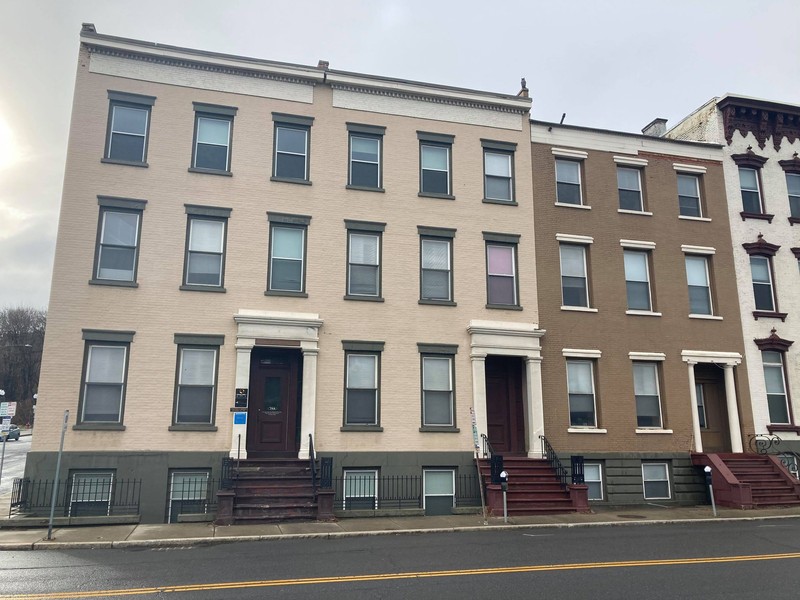
Broadway Row, 1987

744 and 746 Broadway
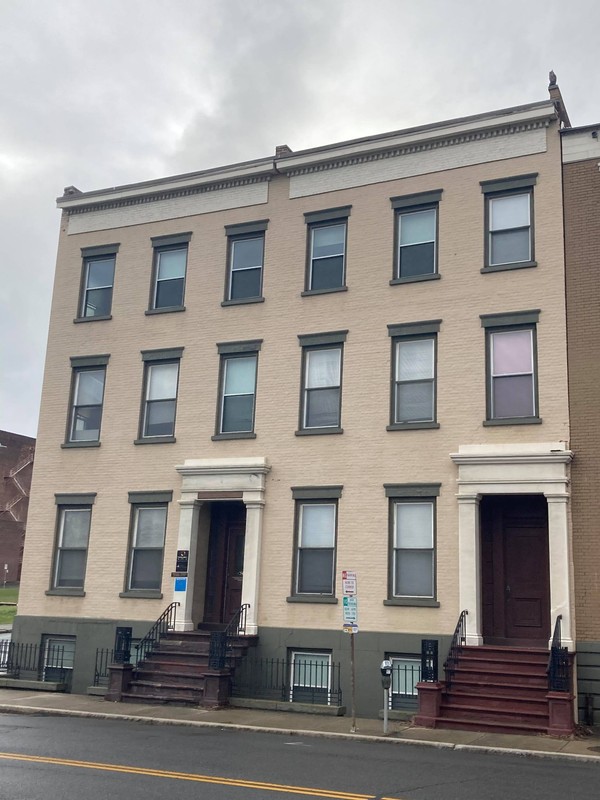
744 Broadway
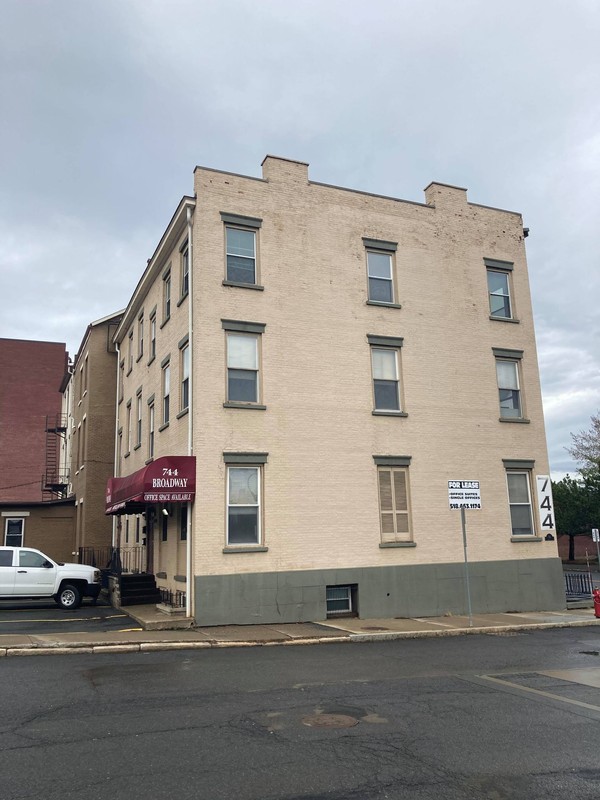
744 Broadway: note the entryway

Looking north towards the stairs and railings for 744-746 Broadway

748 Broadway, Present Day

748 Broadway, 1987 (note the door is there!)

748 Broadway: former entryway

Stairs and railing at 748 Broadway

746-750 Broadway: observe the differences in architectural styles
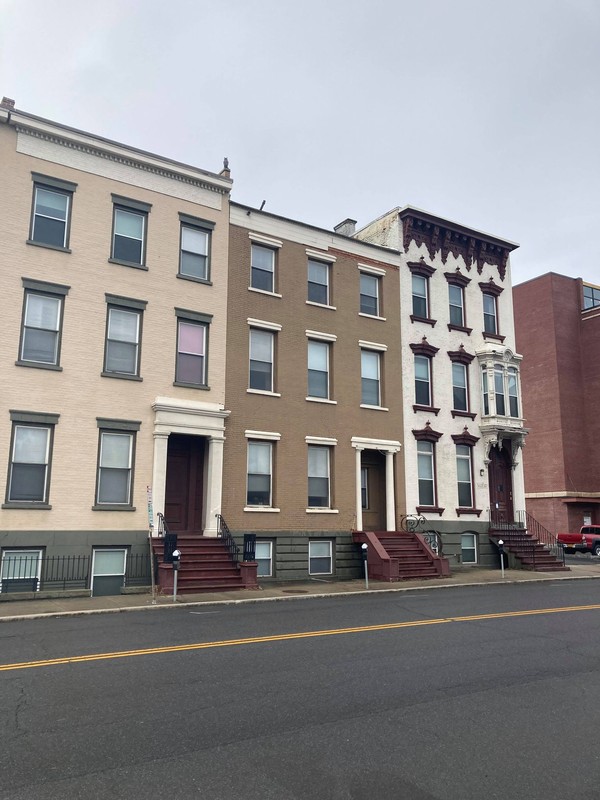
Col. George Talcott
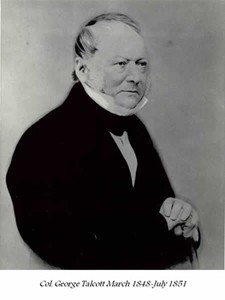

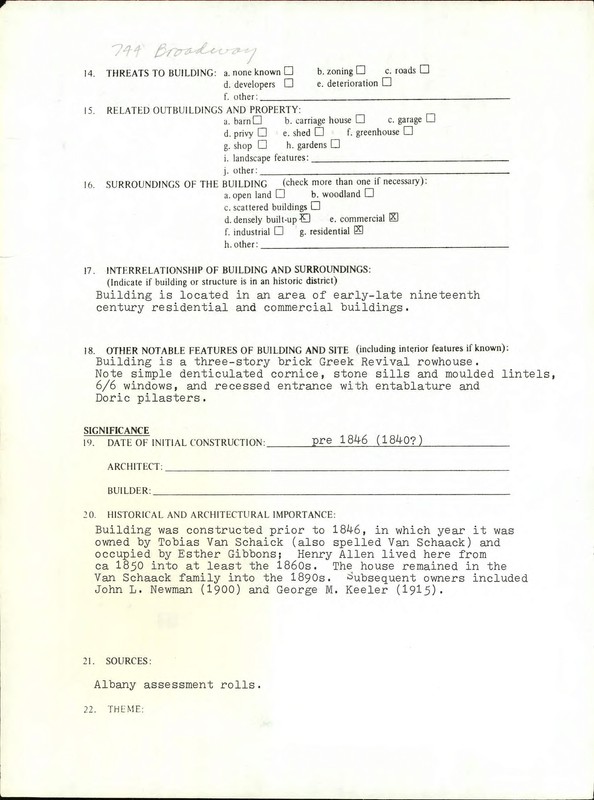
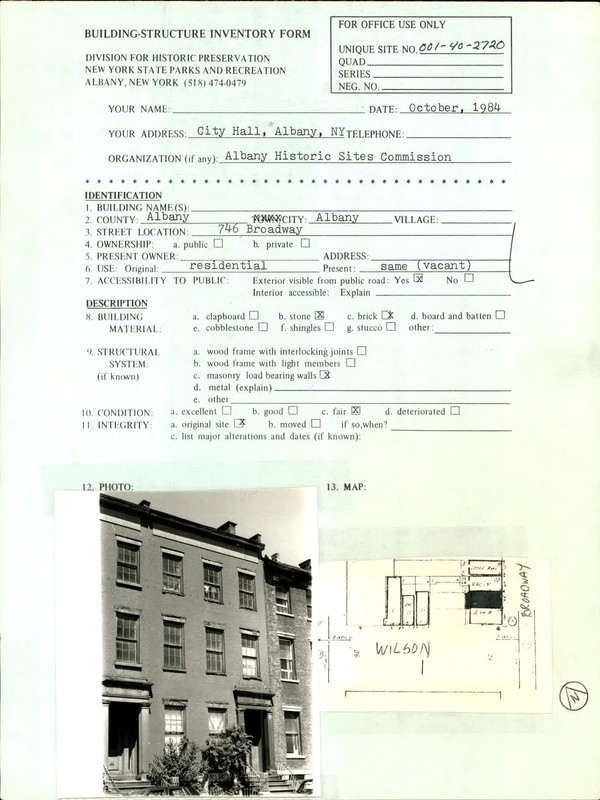

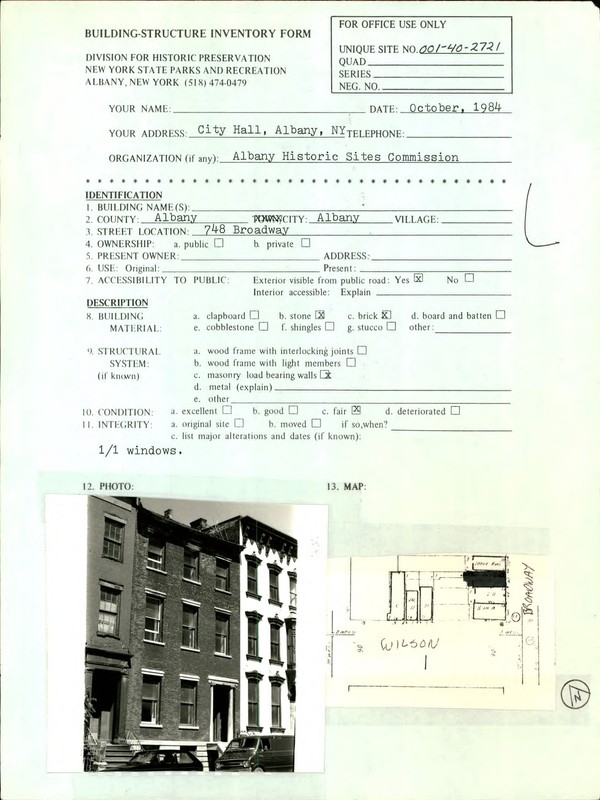

Backstory and Context
Author-Uploaded Audio
Listen to a narration of this entry's description by Kim Parker .
Text-to-speech Audio
The beautiful rowhouses at 744, 746, and 748 Broadway were constructed sometime between 1831 and 1846. During this time, the neighborhood was undergoing rapid expansion due to the opening of the Erie Canal in 1825 and the city's subsequent industrialization. An inlet to the Erie Canal penetrated the Hudson River at the end of Colonie Street, a few blocks from these homes. This helped spur the city’s economy, and soon after, Broadway (north of Clinton Avenue) became home to many of the city’s affluent residents. For years, Broadway was lined with rowhouses, but at the height of 'Urban Renewal' in the mid to late twentieth century, many of the homes were demolished. Today, Broadway Row is the only section of these many rowhouses still standing.
744 and 746 Broadway
The building located at 744 Broadway has a history that is connected to some of Albany’s most notable families. The home was owned by Tobias Van Schaick, a prominent merchant and member of the Van Schaick family of Albany. Tobias was the son of Goose Van Schaick, a Continental Army officer during the American Revolutionary War, and Maria Ten Broeck, of the well known Ten Broeck family of Albany. Tobias did not actually live in this home, according to an Albany directory from 1840. Rather, he had a cottage on the Schenectady Turnpike and lived at 118 North Market (now Broadway).
Esther Gibbons was the first occupant of the home at 744 Broadway and resided there for no more than a decade. Henry Allen, a teller at the New York State Bank, then occupied the home from around 1850 into the 1860s. The home remained in the Van Schaick family until the 1890s. Subsequent owners included John L. Newman (1900) and George M. Keeler (1915).
The rowhouse next to 744 is its twin, 746. It is believed that City Chamberlain Sanford Cobb built the two homes in 1841. The first owner of the home was David E. Gregory; it was occupied by both him and Rufus K. Viele. Gregory was once on the board of directors at the Commercial Bank at 40 State Street, while Viele was a receiving teller at the Bank of Albany. Following Gregory’s death around 1855, Viele owned the home into the 1860s. Subsequent owners included Nelson H. Chase, whose family retained ownership into the first decade of the twentieth century.
This identical pair displays clear elements of Greek Revival architecture - notice the recessed entrance encased by a decorative entablature with Doric pilasters. The doors are surrounded on the sides and top by a narrow band of rectangular panes of glass, called transoms. Unfortunately, the transoms have been painted over on the entrance of 746 but are still visible at 744. The window surrounds are typically far less decorative than the doorways, as can be seen here. Both homes have rectangular moulded sills and lintels. The homes also have a denticulated cornice and wide frieze band that crown the building. In the past, they would've had 6/6 sash windows, but have since been replaced with modern windows - as many buildings on this tour, unfortunately, have been.
748 Broadway
Next to the identical pair is 748 Broadway. It is believed that this building was the first in the row to be built, circa 1831-1833. The building was owned by George Talcott and occupied by his son Sebastian Visscher (S.V.) Talcott. George Talcott was in the army from 1813 to 1851, where he earned the position of Colonel. Before his time in the military, George married Angelica Bogart on November 17, 1810. Two years later, on November 24, 1812, Angelica gave birth to S.V. The Talcotts lived at 212 North Market, and eventually, S.V. grew older and moved into 748 Broadway. S.V. then married Olivia M. Shearman on November 23, 1843, and had five children together between 1844 and 1851. Their second child, Angelica was actually born in the residence on February 24, 1846.
By 1860, the home was passed to Angelica Talcott, and it was occupied by her eldest brother George. It was around this time that both of S.V.’s parents passed away, his mother, Angelica on September 1, 1861 and George on April 25, 1862. Following his father’s passing, S.V. was appointed as Quartermaster General by Governor Horatio Seymour on December 27. In 1876, before the inauguration, S.V. compiled the 'Talcott Pedigree in England and America from 1558 to 1876', as well as 'Genealogical Notes of New York and New England Families', published in 1883. Angelica’s heirs owned the house from the 1860s to the 1890s. Subsequent owners included Mary J. Horner (1900, 1915) and Elizabeth D. Harby.
Although 748 does not look exactly like the twins next to it, it still has many Greek Revival characteristics. Again, it features the recessed entrance with sidelights and stone Doric columns. Unfortunately due to the remodel the original door is no longer there, but you can still see the remnants of the doorway. Similar to its neighbor, 748 has moulded lintels and sills. Lastly, note the modillion cornice.
While there are actually four rowhouses that are a part of Broadway Row, there is a reason we did not include the fourth one, 750 Broadway, in our tour. 750 Broadway was built in 1873, at least four decades after the other three were constructed. With a quick glance, you can see that 750 stands in contrast to the other three. This is because this home is considered an Italianate style rowhouse, rather than the Greek Revival style that we are highlighting in this tour. Interestingly, the land at 750 used to be the garden of the adjacent home at 748 Broadway. Take a look at all the buildings together to see if you can spot the differences!
Sources
"From Albany: Gov. Seymour's Appointments. Arrival of the Europa at Boston." New York Times (1857-1922), Dec 28, 1862. http://proxy.binghamton.edu/login?url=https://www-proquest-com.proxy.binghamton.edu/historical-newspapers/albany/docview/91682497/se-2?accountid=14168.
Hoffman, Lewis G. "Hoffman's Albany Directory for the Years 1840-1841." American Ancestors Digital Library & Archives, 1840. https://digital.americanancestors.org/digital/collection/p15869coll21/id/22617.
Howell, George Rogers. Bi-centennial History of Albany: History of the County of Albany, N.Y., From 1609 to 1886. New York: W. W. Munsell & Co., Publishers, 1886. https://books.google.com/books?id=nWkJAQAAIAAJ&printsec=frontcover&source=gbs_atb#v=onepage&q&f=false.
Building-Structure Inventory Form. Division for Historic Preservation New York State Parks and Recreation. 744 Broadway, Albany NY. CRIS Entry 00140.002719.
Building-Structure Inventory Form. Division for Historic Preservation New York State Parks and Recreation. 746 Broadway, Albany NY. CRIS Entry 00140.002720.
Building-Structure Inventory Form. Division for Historic Preservation New York State Parks and Recreation. 748 Broadway, Albany NY. CRIS Entry 00140.002721.
Building-Structure Inventory Form. Division for Historic Preservation New York State Parks and Recreation. 750 Broadway, Albany NY. CRIS Entry 00140.002722.
Rittner, Don, and Walter Wheeler. "Historic Albany Foundation Oldest Building Inventory (by date)." April 12, 2016. Accessed February 26, 2021. https://static1.squarespace.com/static/5567269ce4b02c6f5096564d/t/570d382862cd94966bf28b7a/1460484139292/OldestBuildingInventory_Date.pdf.
Talcott, S. V. (Sebastian Visscher). "Genealogical notes of New York and New England families / compiled by S. V. Talcott." Albany: Weed, Parsons and Co., 1883. https://lccn.loc.gov/04015526.
Weeks, Lyman Horace, ed. Prominent Families of New York. Revised Edition. New York: The Historical Company, 1898. https://books.google.com/books?id=gr5DtQEACAAJ&printsec=frontcover&source=gbs_atb#v=onepage&q&f=false.
Historic Albany Foundation
CRIS
Historic Albany Foundation
Historic Albany Foundation
Historic Albany Foundation
Historic Albany Foundation
Historic Albany Foundation
CRIS
Historic Albany Foundation
Historic Albany Foundation
Historic Albany Foundation
https://goordnance.army.mil/history/chiefs/talcott.html
